With nearly 100,000 jobs and a payroll of $10.1 billion, Advanced Manufacturing accounts for 8% of the greater Southwest Washington-Portland region’s private sector employment and 11% of payroll. The region’s economy is highly dependent on the manufacturing sector.
Workforce Southwest Washington (WSW) and partners in the Columbia-Willamette Workforce Collaborative (CWCC) recently released an updated Advanced Manufacturing Labor Market Report. First published in 2016, and revised in 2018, COVID delayed the planned 2020 update until recently.
A few highlights from the new report:
Firm Size
Nearly 90% of the Portland Metro region’s Advanced Manufacturing employees work in establishments employing fewer than 50 workers. That holds true for Southwest Washington as well with 95% of manufacturing companies employing 1-50 employees, 4% having 51-250 employees and 1% having greater than 250 employees.

Worker Demographics
Nearly one in four manufacturing workers is 55 years or older and many could retire in the next decade. Looming retirements and career changes mean a steady stream of workers is needed to fill available jobs.
Youth (14-24 years) employment in manufacturing is half that of the overall economy (6% versus 11%).
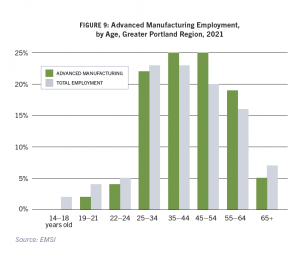
In addition, the sector is overwhelmingly male (72% compared to 52% across all other industries).
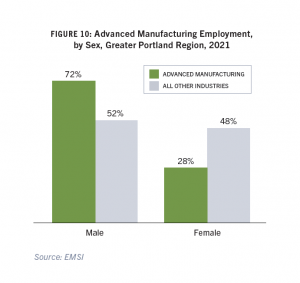
People who identify as white make up the vast majority of the manufacturing workforce. In Southwest Washington, the total number of manufacturing employees is 44,311 of which 40,437 identify as white.
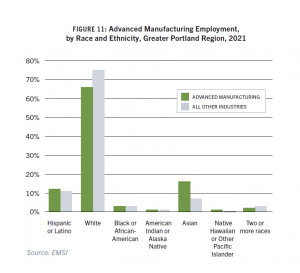
To survive and thrive, companies will need to attract younger workers, women, and candidates from historically underrepresented communities. To be seen as an employer of choice, providing quality jobs will be paramount. Companies must recognize and respond to worker needs by ensuring competitive wages, providing schedule flexibility and robust benefits packages. If you’re not sure where to start, please Contact Alyssa Joyner, WSW’s Senior Project Manager for Manufacturing at ajoyner@workforcesw.org or 503.410.0408. WSW can help!
Occupation Growth
Page 13, Table 2 of the report shows the greatest 10-year projected growth for the Portland Tri-counties area among software developers with 33% growth by 2029. In Cowlitz County, software developers are also projected to have the largest growth at 2.5% followed by welders/cutters/solderers (1.4%) and machinists at 1.3%.
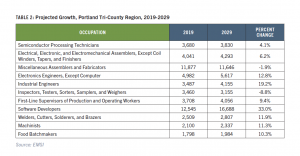
Wages
In some of the largest occupations in advanced manufacturing, our region pays higher than the nation. This can be seen in Table 3 on page 14 where the “location quotient” is above “1.” In addition, many good-paying jobs do not require a four-year degree.
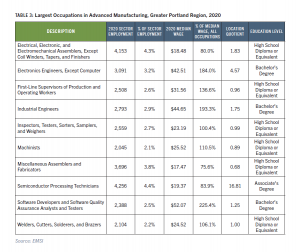
COVID Aftermath
Between 2015 and 2019, Advanced Manufacturing added more than 5,800 jobs across the region, reaching some of the fastest growth rates for the sector in the 21st century. The sector was initially hit hard during the COVID-19 pandemic, losing nearly six percent of its employment base during 2020. Although jobs are returning, the sector’s growth in 2021 was slightly smaller than the overall economic growth in the region.
To meet the need for additional workers, companies are rethinking requirements for hiring and some are focusing on candidate characteristics rather than specific job knowledge. As Christina Almsted, Human Resources Manager for Wood Fiber Group which operates in Ridgefield under the name Simonds International, explained during a December 2021 presentation to industry, workforce and education professions, they can train someone who doesn’t have the exact experience they are hiring for, but applicants must know how to be on time and have the ability to follow instructions.
Local manufacturers are making additional changes to attract more applicants, including:
- Raising wages
- Paying workers while they attend training, including orientation and safety
- Offering flexible shift work that allows employees to sign up for the hours that work for them
- Providing equipment like safety vests and discounts or reimbursement for boots and glasses
- Increasing benefits packages to be more comprehensive and giving employees access to them immediately or within 30 days rather than the prior 90 days or more
- Offering hiring and/or referral bonuses
- Adding benefits like tuition reimbursement
Childcare, however, remains a barrier for many families and will need to be addressed by companies to attract more parents, including women and younger workers, to the industry. Simonds, the 185-year-old cutting tool manufacturer, provides employees a 10% discount to KinderCare.
Resources for Businesses
WSW and its CWWC partners will soon be releasing the Quality Jobs framework which will serve as a blueprint to implement job quality strategies for businesses, workforce boards, local government, service providers, nonprofits, labor and workers. Best practices and other resources will be included in the report which will be available on WSW’s website or by contacting our business services team.
In addition, through June 2022, WSW will reimburse eligible companies for costs to train their existing workforce. Click here to learn more.
WSW and the workforce system have numerous options available to help grow your business. Contact Alyssa Joyner, WSW’s Senior Project Manager for Manufacturing at ajoyner@workforcesw.org or 503.410.0408 to learn about opportunities and get help crafting a strategy to attract, train and retain a skilled workforce that is ready to fill your open positions now and in the future.



